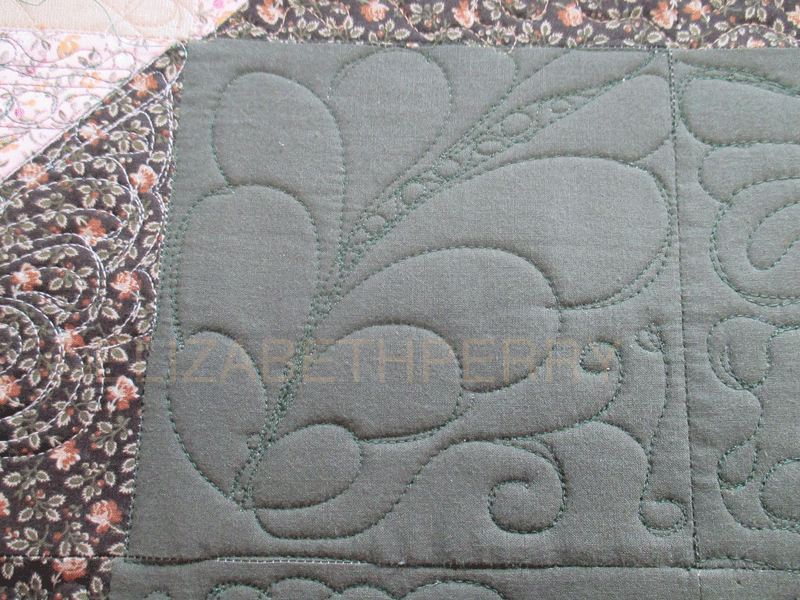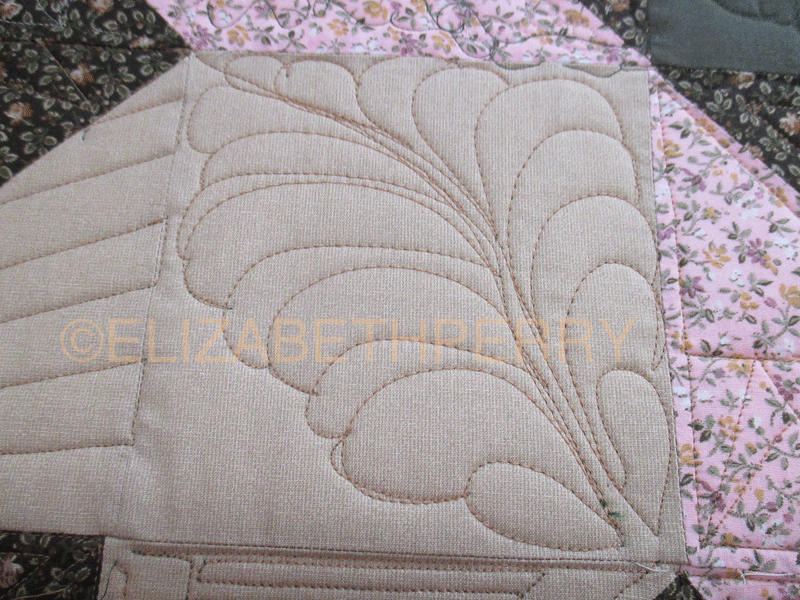Over and over and over and over and over and over. Some looked good. Some looked like crap.
Since I had some nice blank space in the middle of the practice quilt, I decided to just go for it.
As you can see, I improved with each one. The final feather I did not sketch out first.
 | |||
| feathers 1-4 starting at the top left and moving clockwise around |
 | |
| feather 1 |
After I had completed feathers 3 and 4 I went back and tried to fix feather 2. I would not say I fixed it.
 |
| feather 2 |
But I did have some fun trying out the pebbles again.
 | |
| feather 3 |
I decided against filling in the "stem." I could always use the practice but wasn't in the mood for more pebbles.
 | |
| feather 4 |
I do find the first one or two "feathers" off of the stem challenging.
 | ||
| feather-5 |
I do think that sketching first helps
 | |
| feather -6 |
Actually I am pleased with the results. I guess all that time with the odor free, dry erase pens and the white board helped. Thank goodness the pens were odor free. I have smelled the original dry erase pens. They aren't as bad as acetone, but close.
No photos of the ruler work. It is hard to see anything on that print. I reckon that the next practice quilt will have to be solid. I am not going to piece one, though. Not for practice.
I eventually moved to bump back feathers almost exclusively on my domestic machines. Imagine my surprise when I started using my Nolting and discovered that my old style works a lot better.
ReplyDeleteAH You have a Nolting, too! I am practicing both ways.
DeleteYour final two feathers are quite nice. I am so bad with free motion quilting. I finally bought the new robotics from Nolting. Now I am in LOVE! I'm still learning what I can do with it but I'm much happier with my final products.
ReplyDeleteGood for you!
DeleteI have not been brave enough to try feathers. I can do pebbles, mostly. I have to load another quilt on and get going.
ReplyDeleteYes you do. I think that watching Angela Walters helped some. Practice, is the key, I do believe. I spent hours on the white board after I traced the design.
DeleteI subscribed to your blog for the vintage sewing machines. The longarm stuff is pure bonus! Doodling is key to getting the muscle memory built up for any longarm technique, even feathers! And silly me bought big sketch pads so the evidence will always be there and not erased away. When learning on my Gammill I found that starting with "longarm" feathers was easiest, and even easier in non regulated mode. Ditto for pebbles. Small pebbles just don't work with a stitch regulator if you want round pebbles. I know this because my dog has a lot of my practice pieces for his bed. I'm very thankful that we cannot post pictures in the comments, so I don't feel obligated to show my first (disastrous) attempts!
ReplyDeleteInspiring!
ReplyDeleteI think you did very well! I am lousy at feathers, so I don't do them. Maybe later. I did discover on youtube a very generous quilter who demonstrated her "Loopy Clams", and I really like that. It's easy, forgiving, and gives a lot of definition.
ReplyDeletehttps://www.youtube.com/watch?v=VkuEx3baTwY
DeletePerhaps?
Feathers are fun, partly because there are so many variations. Practice helps immensely - you can see progress already. Try making your first feather on the bottom more like a paisley: start with a shallow up curve, come back down to make a rounded tip, stitch up and curve back to the spine. The shape will be more like the later feathers. Look at the third feather on the right in the bottom right block; it's the shape for the first feather. I also have a Nolting and the micro drive handles make small circles much easier. I bought mine used.
ReplyDeleteJoanne